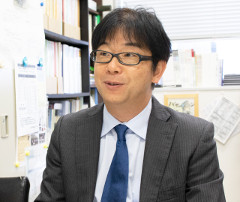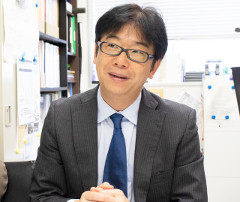Development of artificial materials comparable to autologous bone grafting

In recent years, I think that many people have heard the word “biomaterial,” which refers to a material used in contact with the human body having various types and applications. One familiar example of this is contact lenses.
The artificial bones we are researching are also biomaterials.
I think that “artificial bones” will make many people think of what supports bones that are fractured or have some disability.
For example, an artificial hip joint is composed of a rod-shaped titanium material that is inserted into and fixed to a cylindrical femur, spherical ceramics that generate the movement of the hip joint, and an ultra-high molecular weight polyethylene in the saucer. The implantation of these three materials into the body allows the hip joint to move smoothly.
Since these materials have little effect on the tissues in the body and do not corrode, they remain in the body and continue to function.
On the other hand, some types of artificial bones can be combined with actual bones, or can be absorbed into bones and replace the bones.
For example, “hydroxyapatite,” one of the calcium phosphates, is a material that has a composition very close to that of actual bone. When attached to bone in the body, it binds to the bone and becomes the bone itself. Furthermore, “tricalcium phosphate” is an absorption-replacement type material that dissolves into actual bones and replaces them when placed in the body.
The use of these materials enables recovery from bone diseases and illnesses.
When using these materials, the actual treatment is most often performed by autologous bone grafting. For example, a small portion of the bone to be treated is collected, mixed with apatite to increase the volume, and transplanted to the affected area.
Autologous bone grafting has the advantage that the bone to be transplanted is originally the patient’s own bone, so rejection does not occur, healing is fast, and bone strength increases. For this reason, autologous bone grafting is now the most common treatment, the so-called golden standard.
On the other hand, there is a limit to how much bone can be collected from the affected area. Therefore, bones may be taken from other parts of the body, often from the hipbone.
In that case, not only the affected area, but also a healthy part of the body must be operated on, resulting in an extra burden on the patient’s body. Furthermore, even then the amount of bone collected may still be insufficient.
Accordingly, we are working on creating materials that can achieve results comparable to autologous bone grafting by using only artificial materials, without using actual bones.
The ideal artificial bone is indispensable for a super-aged society
Driving our treatment efforts using artificial bones that reduce the burden on patients as much as possible is the fact that Japan is a super-aged society.
It’s great that Japan is a longevity society, but what is important is to extend the healthy lifespan. We think that artificial bone is one of the measures to do that.
For example, with aging, motor diseases called “locomotive syndrome” are more likely to occur. In short, some kind of physical disability occurs, making it difficult for the body to move. In the worst case, you may be bedridden.
This is partly because the rhythm of bone metabolism breaks down with aging, resulting in bone fragility. If your bones hurt or fracture easily, you will not be able to enjoy your life. One solution to this locomotive syndrome is artificial bone.
As I mentioned earlier, however, the current treatment with artificial bone is centered on autologous bone grafting, in which the burden on the body increases as elderly patients get older.
Bones are always metabolized, and the cells that form new bone are called “osteoblasts.” The formation of bone by the osteoblasts is called “osteoconduction.” However, there is a phenomenon in which bone is created even in the absence of osteoblasts. This is called “osteoinduction.”
In fact, this osteoinduction is expressed in autologous bone grafting. That means the therapeutic effect naturally increases. That’s why this treatment method is so common, it is called the Golden Standard.
In contrast, with apatite, osteoinduction hardly occurs at all, whereas osteoconduction occurs.
However, we believe that it is not impossible to create apatite-based artificial bone that can induce osteoinduction.
For example, by making the material porous, the bone enters the holes and recovery is accelerated. It is known that osteoinduction is more likely to occur depending on the size of the hole. Therefore, we are researching how large the holes should be made.
We believe that one of our missions in chemistry is to “create things that are useful to humans.”
In that sense, our mission is to create artificial bones that are less invasive than autologous bone grafting, have osteoinductive plus bioresorbable-bioreplaceable properties, and have antibacterial and non-infective functions. This is the motivation for our research.
Artificial bone development technology leads to advances in regenerative medicine

In recent years, “regenerative medicine” has been attracting attention. Many researchers approach this field in various ways, and our laboratory is conducting research from our own perspective.
Regenerative medicine is medical treatment that aims to regenerate cells in the event of a disorder in the human body by transplanting cultured cells into the tissues. Our laboratory can culture osteoblasts to create bone-like tissues.
What is important here is actually the “scaffold” for culturing cells.
In our method, first, fibrous apatite is made, and bead-like carbon is mixed with it and baked to make a porous body of apatite-fibers called “apatite-fiber scaffold.”
Next, using a device called a bioreactor, cells are attached to this apatite-fiber scaffold, and the place where the cells are attached is the “scaffold” for cell culture. Cell culture using this method is called three-dimensional circulation culture.
For example, bone marrow is taken from rat bone, from which mesenchymal stem cells are collected. Mesenchymal stem cells are somatic stem cells that have the ability to differentiate into tissues. Accordingly, if they are used for three-dimensional circulation culture and directed to osteoblasts, “regenerated cultured bone (bone-like objects)” can be created. This serves as a substitute for autologous bone.
Our research is still in the experimental stage with rats, but we have almost succeeded.
This research to create a “scaffold” for cell culture is not limited to the development of artificial bones, but can be applied to all types of cell culture. In other words, this research has the potential to become the foundation of regenerative medicine technology.
For example, recently, a human mini-liver was successfully produced by cell culture, but the tissue is about 1 mm in size. If you want to use it for actual treatment, you will need millions of them.
In that case, what is required is a highly efficient cell culture technology, and we believe that the basis for the technology is the “scaffold” for cell culture that we are currently researching.
In other words, it will make it possible to create a tissue with a size that can be applied clinically. That is also what we are aiming for.
It is said we are now in an era when people can live 100 years, but what is important is “extension of healthy lifespan.” To that end, many researchers continue their research every day.
In order to put the results into practical use, various approaches are required such as gaining an understanding basic research, getting a budget for it, and collaborating with industry and academia.
If many of you are interested in and have high expectations from this research, it will lead to smooth progress of the approach.
To that end, we will continue to disseminate information, and hope that everyone will be interested in such information.
* The information contained herein is current as of October 2019.
* The contents of articles on Meiji.net are based on the personal ideas and opinions of the author and do not indicate the official opinion of Meiji University.
* I work to achieve SDGs related to the educational and research themes that I am currently engaged in.
Information noted in the articles and videos, such as positions and affiliations, are current at the time of production.

